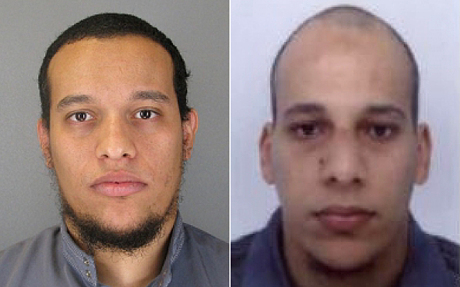The Kouachi Brothers’ Journey to Terror
Abdulrahman Al-Rashed/Asharq Alawsat
Monday, 12 Jan, 2015
The brothers Cherif and Said Kouachi, who carried out the attack against French satirical magazine Charlie Hebdo and claimed to be directed by Al-Qaeda in the Arabian Peninsula (AQAP), have a lot in common with other terrorists who joined extremist groups. What they share is a similar path through school, mosque, and prison. The Kouachi brothers, like many young immigrants in France, held menial jobs including delivering pizzas. They later began to attend Dawaa mosque, in a Paris suburb, where they fell under the influence of an extremist preacher.
Cherif went to jail after getting involved with an extremist group. He completed his education in extremism in prison where cells of prisoners are tasked with teaching and overseeing others on their journeys into extremism. Cherif therefore left prison a terrorist. His brother Said traveled to Yemen where he attended Al-Iman university, overseen by fundamentalist preacher Abdul Majeed Al-Zindani, and subsequently joined AQAP.
The school, the mosque, and prison were therefore stages in the journey of these terrorists, including the man believed to be the leader of the Paris cell who carried out the attack. Djamel Beghal was also a former convict. He was imprisoned for 10 years and was recruited and trained in a French prison, and this is where Cherif met him. Terrorist Mohammad Merah, who killed seven people Toulouse in 2012, had been imprisoned for two years after he was found guilty in an armed robbery. It was also in prison that Merah met extremists who recruited him. In France, there are around 40,000 Muslims in prisons that have been infiltrated by terrorist organizations and where extremism has spread.
This is not a problem exclusive to the Muslims of the West, as prisons are a better place to recruit extremists than schools, mosques and households. Despite attempts to reform them, extremists may remain dangerous even after serving their sentences. One of the Saudis who carried out the terrorist attack on the Saudi border crossing with Iraq around two weeks ago had also served a prison sentence, and one of the perpetrators involved in the attack on a Husseiniya, or Shi’ite meeting house, in the eastern city of Al-Ahsa in November last year was a former convict. There are around 3,000 prisoners in the same kind of facility as the one he was held in. This is a huge number by itself, and a lot more than 3,000 have been released during the past few years, either because of lack of evidence or because they served their sentences. These thousands of potential extremists are a serious source of concern. Their number is increasing and prisons may no longer accommodate them at some point, while the courts will be tied up dealing with them, and they will thus become the security forces’ first concern.
All this will leads us back to the ultimate solution to this problem, which is an intellectual one. Confronting extremists requires an alternative project: moderate Islam. This can be achieved via marketing the culture of moderate and modern Islam—a culture which hasn’t made it to our mosques and universities yet.



















